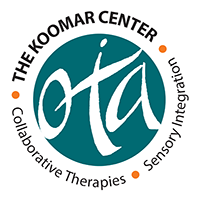Adolescent Occupational Therapy Services
OTA The Koomar Center offers the highest quality services to adolescents within the fields of Occupational Therapy and Speech and Language Therapy. This page describes the different types of Occupational Therapy evaluations that are offered at OTA as well as information on our intervention approaches.

Comprehensive OT Evaluation
Most adolescents require a full comprehensive evaluation in order to begin occupational intervention services. This evaluation gives a complete picture of an individual’s sensory and motor profile along with recommendations for services and accommodations. It includes 3 to 4 hours of direct assessment, a comprehensive detailed written report, and an evaluation feedback meeting. The assessment tools used for this evaluation vary depending on an individual’s age, abilities and needs. Tools used may include Sensory Integration and Praxis Tests (SIPT), Pediatric Examinational Readiness of Middle Childhood (Peeramid), Ayres’ Clinical Observations, OTA-Watertown Sensory Modulation and Discrimination Evaluation, Bruininks-Oseretesky Test of Motor Proficiency, or a number of other assessment tools.
Abridged OT Evaluation
Individuals whose evaluation is covered by Harvard Pilgrim Health Care (HPHC) insurance plans are eligible for our abridged evaluations. This evaluation includes 45 minutes to 1 hour of assessment and includes a brief two-page written report. An evaluation feedback meeting is strongly encouraged to understand the results of the evaluation and our approach to intervention. These meetings are not covered by this insurance plan but are offered at a discounted rate. This evaluation is not comprehensive, but it is sufficient to determine eligibility for occupational therapy services.
Specialty OT Evaluation
On occasion adolescents may benefit from a detailed evaluation that is focused on a specific area such as fine motor/handwriting skills, eating and mealtime performance, listening or visual-vestibular integration. OTA’s specialty evaluations are helpful for examining a specific area of function in an in-depth way to effectively guide intervention. These are recommended when an individual is experiencing an isolated area of difficulty or when an area is identified in another evaluation or over the course of therapy indicates the need for additional assessment. Our specialty evaluations include 1.5-2 hours of assessment, a written report, and an evaluation feedback meeting.
Occupational Therapy Screening
In rare instances, an occupational therapy screening may be recommended. For individuals who currently receive services at OTA The Koomar Center, a screening might be recommended to begin to explore the potential benefit of other services. This might include screening sensory motor capacities or determining if an adjunctive service such as cranio-sacral therapy or listening intervention may be appropriate.
For individuals who are new to OTA, an occupational therapy screening might be recommended during the intake process if it is unclear if the reported concerns are sensory related. In this case, a screening can take place as a first step instead of a comprehensive evaluation. The results of the screening will guide if a comprehensive evaluation is recommended.
A screening consists of a 1-hour screening session; a feedback checklist is provided at the end of the screening.
Occupational Therapy Intervention
Individual Occupational Therapy Intervention
The occupational therapy intervention provided at OTA is tailored to meet the unique needs of each individual and family we work with. Therapy sessions are focused on providing enhanced and targeted sensory input, together with motor challenges, to engage in the “just right challenge” to promote an organized and developed nervous system. Our therapy approach utilizing activities that are motivating, meaningful and collaborative that promote growth of sensory motor foundations that support functional abilities including:
- Completion of daily activities and routines
- Participation in social, sports and academic settings
- Sleep and eating patterns
- Completion of school assignments
- Comfortable engagement in new activities
- Accepting everyday sensations including clothing and noisy environments
At the core of our work is developing a therapeutic relationship that allows for growth in a physically and emotionally safe environment. This is achieved through including the teen in the therapeutic process and including their areas of interest. In addition, therapists are thoughtful about what other factors that might need to be considered to support an individual’s needs. This might include setting up a room in a specific way or determining if it makes sense to work in a quiet small room or to join other age-appropriate peers with their therapists in a shared space.
Our once to twice weekly hour-long therapy sessions encompass direct care, education, and recommendations for support in functional settings such as home and school. Your therapist will consider and utilize a range of approaches during therapy including listening programs, oral motor approaches, manual therapies, and visual vestibular modalities. Additional supplemental services, including collaboration and meeting with family and team members, are also available to comprehensively provide support to meet their ongoing needs. The development of functional goals and objectives for everyone who receives services at OTA is a very important part of the treatment planning process. We look forward to meeting with you during the first month of therapy to establish functional goals that will be measured by improvement in day-to-day skills and activities.
Specialty Occupational Therapy Interventions
Listening Interventions
Music based sound stimulation programs find their origins in the work of Dr. Alfred Tomatis, MD, a French ear, nose and throat specialist. In the 1950s Dr. Tomatis developed the first auditory training program called the Tomatis Method. Generally Tomatis’ principles and theories provide the foundation for other auditory intervention programs.
Currently OTA The Koomar Center offers three different types of auditory intervention, Integrated Listening Systems (ILS) The Listening Program (TLP) and Therapeutic Listening. All programs utilize specially modified music which can be used within treatment sessions and carried over in a home program. They differ in the structure of the program implementation. For more information describing the listening interventions at OTA click here.
Visual-Vestibular Intervention
The visual system is more than just eyesight, or the ability to see clearly. It is also our ability to understand what we see. In school, it is estimated that at least 75% of classroom learning occurs through visual pathways. If an individual is experiencing any visual difficulties, learning will most likely be impacted.
For efficient oculomotor function, complex integration of many sensory systems must occur. According to Josephine Moore, the vestibular system is like a tripod stand that holds a camera, in that it helps hold the head stable so that the eyes can focus on an object. It contributes to bilateral integration which is important for simultaneous functioning of the two eyes together and smooth eye movements across the visual midline. Proprioceptors in the neck, eyes, and body help to coordinate movements to orient the head to the task at hand. All of these inputs together, especially the coordination between the visual and vestibular systems, are important in providing a foundation for the timing and spatial orientation of our movements and for security and comfort to navigate across environments.
- Difficulty participating in gym class, team sports and dance activities.
- Motion sickness in cars, airplanes or boats.
- Difficulty with handwriting or reading.
- Difficulty riding in elevators or on escalators
- Problems learning to drive
- Taking a long time for written or reading schoolwork.
- Difficulty copying from the board
- Discomfort if not in front seat while riding in a car
- Fear of heights
Visual-vestibular intensives at OTA are typically for a three-week duration where the individual attends for 3 to 4 sessions a week working one-on-one with a therapist. Following the three-week intensive the therapist will discuss the recommended course of action. This may include discharge from therapy, continued therapy one time a week or a break from therapy to allow for the information to be integrated before continuing with more therapy. Click here for more information on visual vestibular integration.
The FOCUS Program – Oral Motor/Feeding Intervention
Manual Therapies
Many therapists at The Koomar Center specialize in manual therapies and routinely use these techniques as an integral part of therapy sessions. Sessions specifically devoted to manual therapy are also offered. These sessions may precede or follow the regularly scheduled sensory integration sessions, depending upon the individual’s tolerance. Parents are encouraged to remain with their adolescent children during manual therapy sessions (at least initially) in order to observe the techniques and their effects. Click here for more information.
